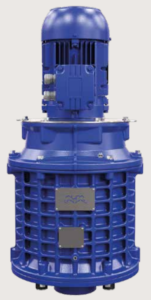Alfa Laval PureVent 2.0
Reducing emissions from internal combustion engines has been a major environmental concern. Up to now, most of the focus has been on exhaust gases. However, crankcase gas has now come into focus as an area where further emission reductions can, and should, be made.
Application
PureVent 2.0 is a compact centrifugal oil mist separator that, when used with medium-speed diesel or gas engines, is capable of removing 98–99.9% of oil from crankcase gases. Recovered oil can be re-circulated to the oil sump and used again for engine lubrication.
Two installation options are available:
- Open design for diesel or gas engines releasing oil-free crankcase gas directly into the atmosphere.
- Closed design for gas engines re-circulating clean gas to the turbocharger, which further reduces atmospheric emissions and does not promote turbocharger fouling.
Benefits
- Internally compatible for separation of EX Zone 1 classified crank case oil mist. 94/9/EC ATEX Directive: The machinery is classified to be installed and operated in a non-explosive atmosphere. Design code: Ex II 2 /- G c IIB T1 X.
- High separation efficiency. Provides 98–99.9% separation efficiency at 40–150 m3/h.
- Stable pressure conditions. No internal pressure drop. Instead there is a suction that extracts the gas from the crankcase. With a fixed valve on the inlet pipe, the crankcase pressure can be adjusted to a preferred level.
- Recovered oil can be re-circulated to the oil sump.
- No hazardous waste associated with conventional filter solutions.
- Long maintenance intervals. Two-year service intervals eliminate the frequent maintenance requirements associated with filter replacement.
Operating principle
The PureVent 2.0 centrifugal sep ar-ator consists of a disc stack made of anti- static carbon fibre reinforced poly amide, which is enclosed in an aluminium housing. Connected to this is an electric motor that drives the disc stack. A frequency converter controls the separator motor and speeds up the motor to optimize separation performance at 7200 rpm.
Uncleaned crankcase gas enters through the inlet at the bottom of the unit and passes into the rotating disc stack. The oil mist is separated in the disc stack; the oil drops are colalected on the separator housing inner wall and drained by gravity through the outlet.
Cleaned air can be re-circulated to the engine turbocharger. This closed system enhances engine performance and safeguards the engine since it elimi-nates risk of turbo- charger fouling or oil accumulation in the intercooler. Most importantly, a closed crankcase ventila-tion system
eliminates the risk of crank-case gas emissions.
For crankcase gas flows above 200 m3/h, it is possible to run two PureVent 2.0 units in parallel and control both using a common variable frequency drive (VFD).
